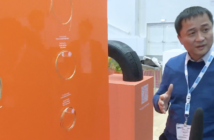This unique patented stud technology, implemented in the new Hakkapeliitta 9, uses different studs that operate during braking, acceleration and concerning, to provide high levels of longitudinal and lateral grip on snow and ice.
“One of our starting points was to develop a completely new studded tire that combines balanced longitudinal and lateral grip with eco-friendliness. A product that enables drivers to remain safe even if the weather and grip level change suddenly. The new Hakkapeliitta 9 has a special tailored stud for the center of the tread and a separate stud for the shoulder areas,” said Juha Pirhonen, VP of R&D for Nokian Tyres.
 In addition to high levels of longitudinal grip, this functional stud also provides high lateral grip on icy and snowy driving surfaces. A new tread pattern also offers stable bare road handling. The Hakkapeliitta 9 behaves in a controlled manner under extreme conditions at the grip limits, and it rolls lighter than the previous studded Hakkapeliitta generation, which results in fuel savings.
In addition to high levels of longitudinal grip, this functional stud also provides high lateral grip on icy and snowy driving surfaces. A new tread pattern also offers stable bare road handling. The Hakkapeliitta 9 behaves in a controlled manner under extreme conditions at the grip limits, and it rolls lighter than the previous studded Hakkapeliitta generation, which results in fuel savings.
The studs in the center area maximize longitudinal grip during acceleration and braking. The tire is supported by the optimal shape of the stud’s body, lower flange and hard metal center part. The longitudinally wide hard metal pin on the center studs offers a maximum amount of grip surface, enabling the best possible longitudinal grip.
“The upper part of the stud body is bevelled, which enables the stud to penetrate even deeper into the ice than before; this further improves braking grip and lateral grip,” Pirhonen said.
The studs on the shoulder areas have been developed in order to provide high levels of lateral grip, which is particularly required when cornering on slippery surfaces. The stud body and flange are different from that of the center studs, and the triaxial hard metal pin has been designed to effectively withstand lateral forces. When cornering in a vehicle, the grip edge of the stud will always encounter a maximal section of the driving surface, which maximizes lateral grip.




